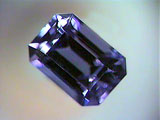![]()
Name:
Tanzanite (zoisite)

Chem:
Ca2Al3Si3O12(OH)
Hydrous calcium aluminum silicate
Crystal:
Orthorhombic (long striated crystals, also bladed crystals)
Color:
gray, yellow brown, pink (thulite), blue-purple (tanzanite), greenish
Refrac. Index:
1.69-1.70
Birefraction:
0.009
Hardness:
6 - 6.5
Spec. Grav.:
3.35
Fracture:
uneven
Cleavage:
perfect
Environment:
restricted to metamorphic rocks
Association:
hornblende, almandine, glaucophane
Locals:
| Norway (thulite) | Tanzania, East Africa | N.C., Calif., USA |
Misc:
named for its locality, Tanzanite (from Tanzania) where the only transparent gem variety is found. Thulite is named after Thule, an archaic name for Norway. (strong pleochroism from blue-violet to violet)
Gem info:
The gem variety, tanzanite, is a very rare gemstone as there is only one place it has ever been found. Tanzanite was found in this locality in 1967, and it is today about exhausted. The stone is said to have low tolerance to ultrasonics, and should not be subjected to this method of cleaning.
Tanzanite is a fairly high valued gemstone and falls in a class just below the three big colored stones, emerald, ruby and sapphire (which it resembles). Tanzanite can be heat treated to enhance its color and remove any yellow or brown overtones.
Thulite is a cabing material and is not found in transparent rough. It is usually pink to brown in color.